PIONEER DDJ-SR2

SETUP
Drivers
Drivers (for both Windows and Mac OSX): Install the latest drivers from https://www.pioneerdj.com/en/support/software/controller/ddj-sr2/
VirtualDJ Setup
Once VirtualDJ is launched, a Login Window will appear to enter your virtualdj.com account credentials.
A Pro Infinity or a Pro Subscription License is required to fully use the Pioneer DDJ-SR2 Without any of the above Licenses, the controller will operate for 10 minutes each time you restart VirtualDJ.
https://www.virtualdj.com/buy/index.html

Click on the "Use Soundcard" button if your speakers are connected to the Master Output of the DDJ-SR2
Click to OK

The unit is now ready to operate.
MIDI Operation
The unit should be visible in the CONTROLLERS tab of Config and the “factory default” available/selected from the Mappings drop-down list. The factory default Mapping offers the functions described in this Manual, however those can be adjusted to your needs via VDJ Script actions.
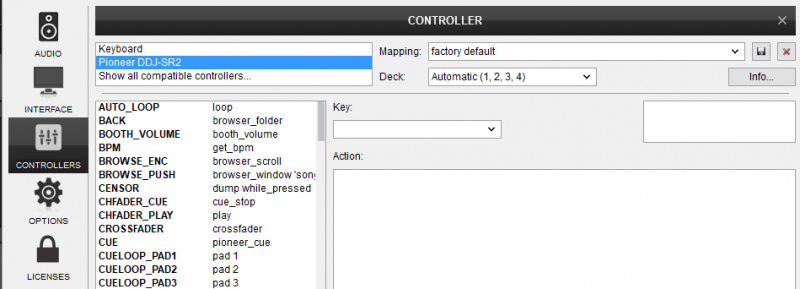
Find more details at https://www.virtualdj.com/wiki/VDJ8script.html
AUDIO Setup
The unit has a pre-defined Audio setup and a special button in the AUDIO tab of Config to provide that. Alternative Audio setups can be applied in the same window.
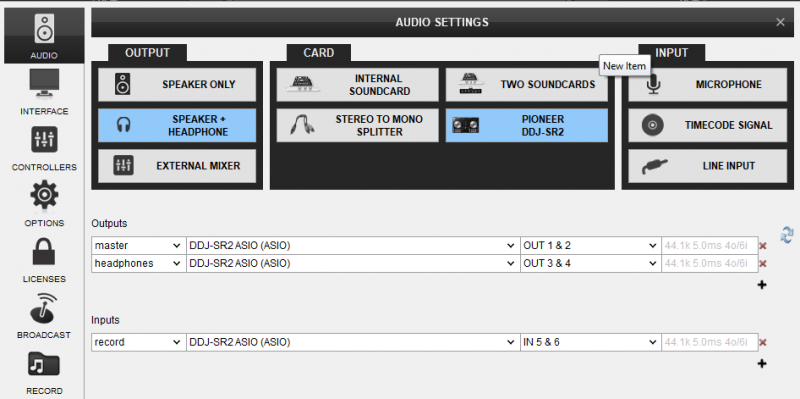
Alternative audio configurations can be applied depending on the routing of the CH1/CH2 Inputs. See Inputs & Recording
For further software settings please refer to the User Guides of VirtualDJ 8.
https://www.virtualdj.com/manuals/virtualdj8/index.html
Refer to the manual of the unit for further features-settings. https://www.pioneerdj.com/en/support/documents/controller/ddj-sr2/
LAYOUT

The functionality of each button, knob and connection per section (as shown in the image above) will be explained in detail in the following chapters
S SHIFT Hold this button down to access secondary functions of Pioneer DDJ-SR2 (mainly in black lettering inside a gray box)
A Mixer Controls
B Browser Controls & Source Select
C Deck Controls
D Effects
E Pads
F Front & Rear
MIXER CONTROLS
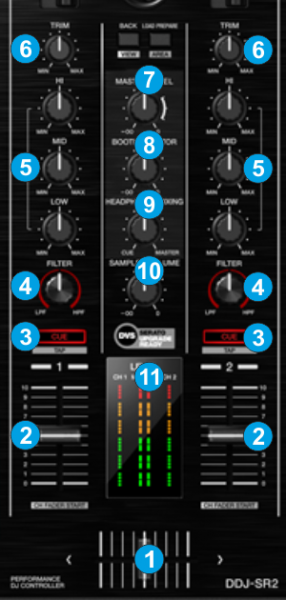
- CROSSFADER: Blends audio between the left and right assigned channels.
- VOLUME: Alter the output Volume of the left/right assigned Mixer Channel
While SHIFT is held down, the VOLUME faders will stop the deck at the previously selected Cue point when these reach the minimum level (zero) and will start playing the deck (in sync with the opposite/master deck) if those move from the zero position. (Fader Start)
The Fader Start/Stop/Sync functionality can be enabled/disabled from the DDJ-SR2 Utilities. See Settings chapter - CUE (PFL). Press this button to send the selected channel's pre-fader signal to the Headphones Channel for monitoring. When engaged, the button will be lit.
Hold SHIFT down and then use these buttons to manually tap the tempo of the loaded track. - FILTER. Applies a High Pass/Low Pass Filter on the left/right selected deck(middle position is Off position).
- EQ (Low/Mid/Hi) Adjust the low/middle/high (bass/mid/trebble) frequencies of the selected left or right software deck.
- TRIM: Adjusts the pre-fader output level (gain) of the mixer channel.
- MASTER VOLUME : Adjusts the Master Output Volume (Hardware operation but its movement is visible on VirtualDJ GUI)
- BOOTH MONITOR : Adjusts the Output Volume of the Booth Output (Hardware operation)
- HEADPHONES MIX: Blends audio signal in Headphones between the CUEed decks and the Master Output. When the knob is at the minimum left position, only decks that have the CUE/PFL turned on will be routed in the Headphones Output. When the knob is at the maximum right position, only the Master Output audio signal will be routed in the Headphones Output.
- SAMPLER VOLUME: Adjusts the Master Volume of the VirtualDJ Sampler.
- LEVEL METERS VIEW: The middle LEDs indicate the overall Output level of the Master Output (handled by the Hardware). The left and right LEDs will indicate the pre-fader output volume of the left-right selected deck (handled by VirtualDJ).
BROWSE CONTROLS & SOURCE SELECT

- BROWSE Turn this knob to scroll through tracks or folders, depending on the focused Browser List
Hold SHIFT down while turning the knob to scroll faster
Push this knob to toggle focus between Songs/Files and Folders Lists
Hold SHIFT down and then push the knob to .set the focus to the Sideview List. - BACK: Sets focus to the Folders list. If focus is on the Folders List, use this button to open/close sub-folders.
Hold SHIFT down and then use this button to cycle Sideview through the available views (Automix, Sidelist, Sampler, Karaoke and Clones) - LOAD PREPARE: Use this button to add the selected track to the Automix list of SideView. Hold SHIFT down and then use this button to open/close Sideview Browser List
- LOAD: Press this button to load the selected track from the Browser to the left/right selected Deck.
Fast double-press this button to load the other's deck track to the left/right selected deck (clone)
Hold SHIFT down and then use the left LOAD button to sort the tracks of the Songs list by BPM and the right LOAD button to sort tracks by Artist. - DECK/SOURCE SELECT: Each one of these Select switches assign a software Deck or a PHONO/LINE Input to the left or right mixer channel.
When the Left Selector is at the DECK 1 position, the left side of the DDJ-SR2 (Mixer and Deck) controls VirtualDJ Deck 1 (LOAD button is lit red)
When the Left Selector is at the DECK 3 position, the left side of the DDJ-SR2 (Mixer and Deck) controls VirtualDJ Deck 3 (LOAD button is lit orange)
When the Left Selector is at the PHONO/LINE position, the left side of the DDJ-SR2 Mixer controls the signal of the INPUT 1 (LOAD is off). The left Deck panel of the unit is still controlling Deck 1
When the Right Selector is at the DECK 2 position, the right side of the DDJ-SR2 (Mixer and Deck) controls VirtualDJ Deck 2 (LOAD button is lit red)
When the Right Selector is at the DECK 4 position, the right side of the DDJ-SR2 (Mixer and Deck) controls VirtualDJ Deck 4 (LOAD button is lit orange)
When the Right Selector is at the PHONO/LINE position, the right side of the DDJ-SR2 Mixer controls the signal of the INPUT 2 (LOAD is off). The right Deck panel of the unit is still controlling Deck 2
DECK CONTROLS

- PLAY: Play/Pause the track. Hold SHIFT and then press this button to play the track in Stutter mode (while pressed)
- CUE: When the Deck is paused, you can set a temporary Cue Point by moving the Platter to place the Audio Pointer at the desired location and then pressing the Cue Button. During playback, you can press the Cue Button to return the track to this Cue Point. (If you did not set a Cue Point, then it will return to the beginning of the track.). If the Deck is paused, you can press and hold the Cue Button to play the track from the Temporary Cue Point. Releasing the Cue Button will return the track to the temporary Cue Point and pause it. To continue playback without returning to the Temporary Cue Point, press and hold the Cue Button, then press and hold the Play Button, and then release both buttons.
Hold SHIFT and then press this button to return to the beginning of the track - SYNC: Syncs the deck with the opposite one. Hold SHIFT and then press this button to set the deck as Master Deck. Using 4 decks skins, all other decks will sync to the Master Deck.
- JOG: Touch sensitive platter for scratching (vinyl mode) or bending (CD Mode). Hold SHIFT and use the JOG in Seek (Search) mode. The Jog is also used to adjust the Beat Grid (CBG) and fine-adjust the Loop In and Out points of a Loop.
The LED Ring of the Jog can display various information and by default will be red when Deck 1 and Deck 2 are selected as Mixer Channel sources, Orange when Deck 3 and Deck 4 are selected and Off when the PHONO/LINE Inputs are selected as Mixer Channel sources. See Settings Chapter for further details. - GRID SLIDE: Press and hold this button and then move the Jogwheel to shift the CBG of the track forward/backwards in time.
Hold down SHIFT and press this button to reanalyze the BPM of the track and clear any changes you may have made before. - GRID ADJUST: Press and hold this button and then move the Jogwheel to adjust the width of the CBG of the track (equal to adjust the BPM of the track), keeping the First Beat position unchanged.
Hold down SHIFT and press this button to set the current position of the track as the First Beat. - CENSOR: Press and hold this button to play the track backwards. On release the track will resume playing from the position it would have been if the button was never pressed.
Hold SHIFT down, and then use this button (momentarily) to play the track backwards. Press again to play forward. - PANEL : (Available on left side only) Use this button to cycle though the available Mixer panels of the default VirtualDJ GUI (Mixer, Video, Scratch and Master).
Hold SHIFT down and then press this button to toggle between the normal and Large Browser (with Mini Decks) views. - NEEDLE SEARCH: The length of this strip represents the length of the entire track. Place your finger on a point along this sensor to jump to that point in the track (song position). Please note that while a deck is playing “on air” the strip search will not function in order to prevent sudden accidental jumps that may occur if you touch the stripe by accident while you operate other controls. If you want to jump on a new position while the track is “on air” hold down SHIFT button first and then touch the strip to bypass security.
- SLIP: Enables Slip Mode on left/right deck. Several software functions (such as Jogwheel movements, HotCues and Loops) will apply temporary on the track, and the track will return to the position it would have been when those functions are not triggered.
Hold SHIFT and then use this button to set the Jog to Vinyl/Scratch mode (LED will be turned on) or Cd/Bend mode (LED will be Off) - PITCH FADER : Adjusts the Tempo of the track loaded to the left/right selected Deck
- KEYLOCK: Press this button to enable/disable the Master Tempo (Key Lock) of the deck. Press and hold the same button for more than 2 seconds to reset the Tempo (PITCH) to zero position.
Hold SHIFT and press this button to select the next available Pitch range for the PITCH/Tempo Slider. - KEY SYNC : Press this button to match the key of the left/right selected deck to the value of the opposite (or Master) deck
- KEY RESET : Press this button to reset the key of the left/right selected deck to its original value
- KEY ADJUST : Use these buttons to move the key of the track by 1 semitone plus/minus. When both LEDs of these buttons are off, the key is at its original value.
- AUTOLOOP: Enables/disables a Loop. of the selected size in beats
- 1/2X: Halves the size of the Loop.
When a Loop is active, hold SHIFT down and then press this button to move the loop backwards by 1 beat. - 2X: Doubles the size of the Loop.
When a Loop is active, hold SHIFT down and then press this button to move the loop forward by 1 beat. - IN: Use this button to set current track's position as the start position of a manual loop.
When loop is active use this button to set the Jogwheel to Loop In Adjust mode (LED will flash) and then use the Jogwheel to fine-adjust the Loop In position.
Hold SHIFT down and then use this button to save the current Loop to the default slot. If a Loop is saved, use this button to activate (load & prepare) the loop. Hold SHIFT and then hold the same button for more than 2 seconds to delete the saved loop. - OUT: Use this button to set current track's position as the end position of a manual loop.
When loop is active use this button to set the Jogwheel to Loop Out Adjust mode (LED will flash) and then use the Jogwheel to fine-adjust the Loop Out position.
Press and hold this button for more than 2 seconds to trigger a 4 Beats loop at the current position.
Hold SHIFT down and then use this button to activate and jump to the last triggered loop. Press again to exit the loop
EFFECT CONTROLS
The Single Effect mode offers one effect slot but more parameters controls per effect.
The Multi Effects mode offers 3 effect slots (to trigger more than 1 effect at the same time – chained effects).
The selection between those 2 modes is done via the VirtualDJ GUI
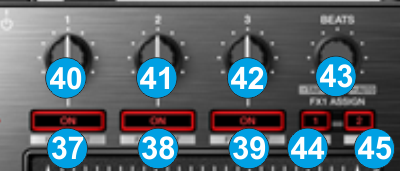
Single Effect mode
In this mode a single Effect is controlled with up to 6 Parameters and 2 Effect buttons. Only the first 2 Parameters are visible on the GUI. More Parameters and Effect buttons can be viewed in the FX GUI (opened from the + button on the GUI or using SHIFT+FX1 ON button on the DDJ-SR2)
- FX1 ON. Press this button to enable/disable the selected effect to the Left/Right selected deck.
Hold SHIFT down and then use this button, to open/close the FX GUI of the selected Effect on the right side of the Browser and view all the available Parameters and Buttons. - FX2 ON. Press this button to select the previous effect from VirtualDJ Effects list.
Hold SHIFT down and then use this button, to enable/disable the 1st FX button of the selected effect (if available). - FX3 ON. Press this button to select the next effect from VirtualDJ Effects list.
Hold SHIFT down and then use this button, to enable/disable the 2nd FX button of the selected effect (if available). - FX1 knob. Controls the 1st Parameter of the selected effect.
Hold SHIFT down to control the 4th Parameter of the selected effect (if available). - FX2 knob. Controls the 2nd Parameter of the selected effect.
Hold SHIFT down to control the 5th Parameter of the selected effect (if available). - FX3 knob. Controls the 3rd Parameter of the selected effect.
Hold SHIFT down to control the 6th Parameter of the selected effect (if available).
Multi Effects mode
In this mode 3 different Effects can be applied and controlled with up to 2 Parameters for each FX slot. Only the first Parameter is visible on the GUI (and the 2nd Parameter while SHIFT is held down on the DDJ-SR2). More Parameters and Effect buttons can be viewed in the FX GUI (opened from the + button on the GUI)
- FX1 ON. Press this button to enable/disable the selected effect of FX Slot 1.
Hold SHIFT down and press this button to select the next available effect for FX Slot 1. - FX2 ON. Press this button to enable/disable the selected effect of FX Slot 2.
Hold SHIFT down and press this button to select the next available effect for FX Slot 2. - FX3 ON. Press this button to enable/disable the selected effect of FX Slot 3.
Hold SHIFT down and press this button to select the next available effect for FX Slot 3. - FX1 knob. Controls the 1st Parameter of the selected effect of FX Slot 1.
Hold SHIFT down to control the 2nd Parameter of the selected effect of FX Slot 1. - FX2 knob. Controls the 1st Parameter of the selected effect of FX Slot 2.
Hold SHIFT down to control the 2nd Parameter of the selected effect of FX Slot 2. - FX3 knob. Controls the 1st Parameter of the selected effect of FX Slot 3.
Hold SHIFT down to control the 2nd Parameter of the selected effect of FX Slot 3.
VIDEO EFFECTS & OTHER VIDEO CONTROLS
- BEATS.
Use the left-side encoder to select a Video Transition.
Push the left encoder to trigger the selected Video Transition. The selected Video Transition will automatically apply when the Crossfader is moved from one side to the other and the AUTO or LINK Video Crossfader modes are enabled.
Hold SHIFT down and then use the left encoder to adjust the 1st Parameter of the selected Video Transition (if available). The Parameters of the selected Video Transition are not visible on the default VirtualDJ GUI.
Hold SHIFT down and then push the left encoder to open/close the FX GUI of the selected Video Transition at the right side of the Browser to view all of its Parameters (if available)
Use the right-side encoder to select a Video Effect for the Master Video Output
Push the rightencoder to trigger the selected Video Effect.
Hold SHIFT down and then use the right encoder to adjust the 1st Parameter of the selected Video Effect (if available). The Parameters of the selected Video Effect are not visible on the default VirtualDJ GUI.
Hold SHIFT down and then push the right encoder to open/close the FX GUI of the selected Video Effect at the right side of the Browser to view all of its Parameters (if available) - ASSIGN 1.
Use this button on the left side of the DDJ-SR2, to manually assign Deck 1 as left side of the Video Crossfader (LED will be lit). Press to disable manual assignment (LED will be off) and allow VirtualDJ to automatically assign the Left side of the Video Crossfader based on the Left selected Deck.
Use this button on the rightside of the DDJ-SR2, to manually assign Deck 2 as right side of the Video Crossfader (LED will be lit). Press to disable manual assignment (LED will be off) and allow VirtualDJ to automatically assign the Right side of the Video Crossfader based on the Right selected Deck.
Hold SHIFT down and then use the button on the left side of the DDJ-SR2 to enable/disable Auto Video Crossfader mode. When enabled, the Video Crossfader position will be smart positioned by VirtualDJ based on the Decks that are currently playing on air
Hold SHIFT down and then use the button on the right side of the DDJ-SR2 to enable/disable the 1st FX button of the selected Video Effect (if available) - ASSIGN 2.
Use this button on the left side of the DDJ-SR2, to manually assign Deck 3 as left side of the Video Crossfader (LED will be lit). Press to disable manual assignment (LED will be off) and allow VirtualDJ to automatically assign the Left side of the Video Crossfader based on the Left selected Deck.
Use this button on the rightside of the DDJ-SR2, to manually assign Deck 4 as right side of the Video Crossfader (LED will be lit). Press to disable manual assignment (LED will be off) and allow VirtualDJ to automatically assign the Right side of the Video Crossfader based on the Right selected Deck.
Hold SHIFT down and then use the button on the left side of the DDJ-SR2 to enable/disable Link Video Crossfader mode. When enabled, the Video Crossfader position will follow the one of the Audio Crossfader
Hold SHIFT down and then use the button on the right side of the DDJ-SR2 to enable/disable the 2nd FX button of the selected Video Effect (if available)
PADS
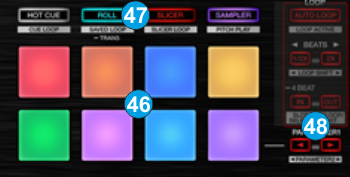 The 8 RGB Pads offer various functions, depending on the selected Pad mode. Each of the 4 Pad mode buttons offers 2 modes (hold SHIFT and then press the PAD MODE button to access the additional mode). The modes represent a page of the PADS section on the default VirtualDJ GUI.
The 8 RGB Pads offer various functions, depending on the selected Pad mode. Each of the 4 Pad mode buttons offers 2 modes (hold SHIFT and then press the PAD MODE button to access the additional mode). The modes represent a page of the PADS section on the default VirtualDJ GUI.An additional (hardware) TRANS mode is available when the ROLL mode button is pressed for more than 2 seconds.
- PADS: The 8 Pads offer different functionality depending on the selected mode. See next chapters for further details.
- PAD MODE: Press any of the 4 available Pad mode buttons to set the Pads to Hotcues, Loop Roll, Slicer or Sampler mode.
Hold SHIFT down and then press one of the 4 Pad mode buttons to set the Pads to CueLoop, Saved Loop, Beatjump and KeyCue mode.
Hold the ROLL mode button for more than 2 seconds to select the hardware TRANS mode.
All 9 available Pad modes are explained in details in the next chapters - PARAMETER: These buttons control the Parameters of the selected Pad mode.
HOT CUES
Press the HOT CUE mode button to set the PADs to Hot Cue mode.
Each one of the 8 pad assigns a Hot Cue Point (1 to 8) or jumps the track to that Hot Cue Point (if assigned).
When a Hot Cue Button is unlit, you can assign a Hot Cue Point by pressing it at the desired point in your track. Once it is assigned, the Hot Cue Button will light on.
The color of the Pad depends on the setting nonColoredPOI or the assigned color from the POI Editor.
Hold SHIFT and then press a pad to delete its assigned Hot Cue Point.
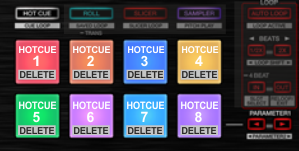

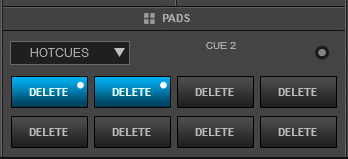
Use the PARAMETER buttons to jump the song to the previous/next assigned HotCue point.
Hold SHIFT and then use the PARAMETER buttons to jump 1 beat backwards/forward.
Read further details about Pads in the VirtualDJ 8 manual
LOOP ROLL
Press the ROLL mode button to set the PADs to Loop Roll mode.
Press one of the 8 pads to trigger a momentary Loop Roll. Once the Pad is released, the track will resume playing from the position it would have been if the Loop Roll was never triggered. The exit point will be visible on the waveform of the VirtualDJ GUI with an additional “running” play marker.
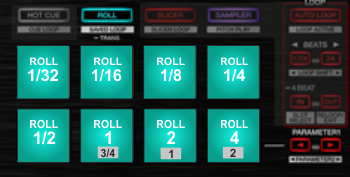

Hold SHIFT to get a ½, ¾, 1 and 2 beats Loop Roll sizes for the 4 low pads.
Use the Page menu to apply the Loop Rolls to Video.
The PARAMETER buttons have no functionality in this mode.
Read further details about Pads in the VirtualDJ 8 manual
SLICER
Press the SLICER mode button to set the PADs to SLICER mode.
The 8 pads represent 8 sequential "Slices" in the Beat Grid. The currently playing Slice is represented by the currently green lit pad. The light will move through the pads as it progresses through each 8-Slice phrase. Press a pad to repeat that Slice (hold it down if you want to keep looping it).
Once the Pad is released the track will continue to play from the position it would have been if the pad was never pressed.
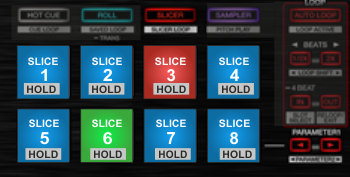

Hold SHIFT down and then use the Pads to repeat the memorized Slices (the Slices played/repeated last time)
Use the PARAMETER buttons to adjust the length of the Loop applied to the slice. Hold SHIFT[/color] down and then use the PARAMETER buttons to adjust the step (size) of the Slices
Read further details about Pads in the VirtualDJ 8 manual
SAMPLER
Press the SAMPLER button to set the PADs to Sampler mode.
Each one of the 8 pads triggers a sample from the selected Sampler Bank of VirtualDJ. If a bank has less than 9 samples, both sides of the DDJ-SR2 will control the same samples. If a bank has more than 8 samples, the left side of the DDJ-SR2 will control samples 1 to 8 and the right side samples 9 to 16. The PAD will be lit if a sample slot is loaded and will blink if triggered.
Press the pads to trigger a sample. Depending on the selected trigger Pad mode, use SHIFT and the same pads to stop the sample.
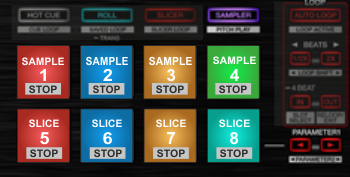

Use the PARAMETER buttons to select the Sampler Bank (previous/next).
Hold [SHIFT down and then use the PARAMETER buttons to select the Trigger Pad mode (on/off, hold, stutter or un-mute)
Read further details about Pads in the VirtualDJ 8 manual
CUE LOOP
Hold SHIFT and then press the HOTCUE mode button to set the PADs to Cue Loop mode.
In this mode each one of the 8 pads assigns a Hot Cue Point or jumps the track to that Hot Cue Point, but in both cases, it also triggers a Loop at that point (momentary or toggle depending on the selected mode from the Page menu).
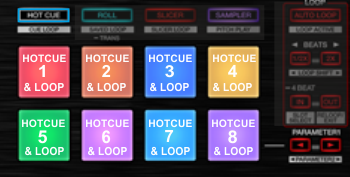
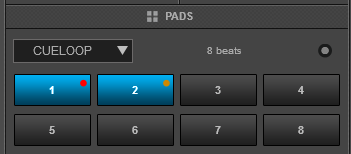
Hold SHIFT and then press a pad to stutter/jump to the Hotcue (loop will remain triggered)
Use the PARAMETER buttons to half/double the size of the triggered Loop.
HoldSHIFT and then use the PARAMETER buttons to select the On/Off (Toggle) or Hold (momentary) Loop trigger mode.
By default the Cue Loops will be quantized. This can be turned off/on from the Page Menu on the GUI.
Read further details about Pads in the VirtualDJ 8 manual
SAVED LOOPS
Hold SHIFT and then press the ROLL mode button to set the PADs to Saved Loops mode.
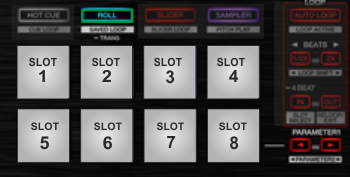

Each one of the 8 pad represents a slot to save and recall a loop.
Press a Pad to save (and trigger at the same time - if not already) a Loop at the current position.
Hold the same Pad down for more than 2 seconds to delete the saved loop from the slot.
When a Loop is saved to a slot, use the same Pad to load* (enable) the saved loop, but not jump to its position if the loop is saved to a later position than the current one (loop load and prepare).
Hold SHIFT and then use the same Pad to load* (enable) the saved loop, and jump to its position.
*Note that only 1 Loop can be enabled each time.
Use the PARAMETER buttons to half/double the size of the Loop.
Hold SHIFT and then use the PARAMETER buttons to move the Loop back/forth in time by 1 beat steps.
Read further details about Pads in the VirtualDJ 8 manual
PADS - BEATJUMP
Hold SHIFT down and then press the SLICER mode button to set the Pads to Beat Jump mode
In this mode, the 8 Pads will jump the track backwards/forward by the amount of beats depending on the selected Beatjump page (from 1/8 beats to 32 Bars)
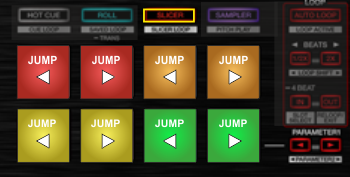
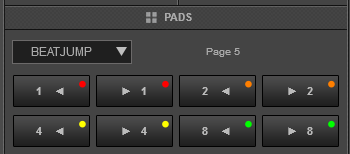
Use the PARAMETER buttons to select the Beatjump bank page (previous/next).
Read further details about Pads in the VirtualDJ 8 manual
KEY CUE
Hold SHIFT and then press the SAMPLER mode button to set the PADs to Key Cue mode.
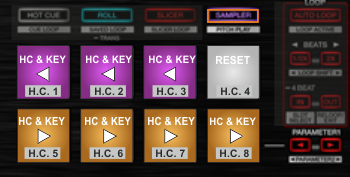
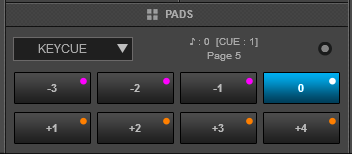
Each of the 8 Pads triggers the selected Hotcue point (or the Temporary Cue if none selected or not available) at a selected Key semitone (from -7 to +7).
Eight different pages/banks are offered with various semitone values to use and a 0 value in order to reset the key to its original value is always offered in all pages.
Each time a Pad is pressed, the track will jump to the selected Hotcue point and will also alter the Key of the track to the value designated by its assigned value.
Hold SHIFT and then press a Pad in order to select a different Hotcue for the Key pads to trigger.
Use the PARAMETER buttons to adjust the Key of the track without triggering the Hotcue.
Hold SHIFT and then use the PARAMETER buttons to select a different page/bank with different key semitone values.
Read further details about Pads in the VirtualDJ 8 manual
TRANS MODE
Press the ROLL mode button for more than 2 seconds to set the PADs to TRANS mode. This mode is hardware/firmware controlled and no specific Pad page will be loaded to the VirtualDJ GUI.
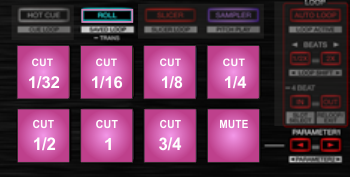
In this mode the 8 Pads mute the Volume of the track repeatedly (depending on the track’s tempo) as long as the pad is pressed, creating a cut effect. Each one of the pads offers a different speed in beats (see image). The last pad offers a mute in the Volume of the track (without repeat).
The PARAMETER buttons have no functionality in this mode
FRONT & REAR PANELS

- HEADPHONES SOCKET Connect your Headphones for monitoring using the 1/4" or 3/4" socket
- HEADPHONES VOLUME. Adjust the Output Volume of the Headphones/Prelisten Channel
- MIC VOLUME. Adjust the Output volume of the Microphone Input (connection at the rear panel)

- BOOTH OUTPUT (TRS) Alternative Output for booth monitoring via 1/4" (TRS) cables. The level of this output is controlled from the top panel
- MASTER OUTPUT (RCA). Un-balanced Main Output. Connect your amplifier or amplified speakers using common RCA cables. The Level of this Output is controlled from the top panel
- MASTER OUTPUT (XLR/). Balanced Main Output. Connect your amplifier or amplified speakers using common XLR cables. The Level of this Output is controlled from the top panel
- INPUTS 1 & 2. Connect your analogue media sources (CD, MP3 players etc). Inputs can be routed directly through the Master Output or through the DJ Application via the USB Audio Interface , depending on the selected mode. See details at the Inputs Chapter
- MIC INPUT. Connect your Microphone using a proper 1/4" cable/adapter The Volume of this Input is controlled from the Front panel. See further details for the Microphone Input at the Inputs Chapter
- USB. Connect the DDJ-SR2 with your computer via a USB port using the provided USB cable
- DC 12V PLUG. Connect the provided AC/DC Power adapter.
- POWER. Power On/Off Switch. Power on the unit after all connections are done
INPUTS & RECORDING
INPUTS CH1 & CH2
The DDJ-SR2 offers 2 stereo Inputs (connections at the rear panel CH1 & CH2) that can be used with any analogue source (such as CD/MP3 Players) and can be routed either to the software or directly to the Master Output depending on the selected Inputs Route Mode
How to select the Inputs Route Mode:
- While the DDJ-SR2 is powered off, hold both left SHIFT and left PLAY buttons and then power on the unit.
- Release SHIFT and PLAY buttons
- Turn the right-side KEYLOCK button on - LED On - to select the Hardware Inputs Route mode
Turn the same button off - LED Off - to select the Software Inputs Route mode - Power off the DDJ-SR2 to save your selection.
Hardware Inputs Route mode
This mode is useful when the DDJ-SR2 needs to operate as stand-alone mixer (without VirtualDJ running)
When the Hardware mode is selected :
- The audio signal from the Inputs CH1 and CH2 is routed directly to the Master Output when the SOURCE Select switches are set to PHONO/LINE positions.
- Only the TRIM and VOLUME will affect the level of these Inputs. The EQ and FILTER knobs will have no effect.
- The Audio Setup of VirtualDJ needs to be set without any Line Ins (default configuration)

Software Inputs Route mode
This mode is useful for Timecode (DVS) functionality or when the Inputs of the DDJ-SR2 need to be routed to a VirtualDJ deck as Line Input to apply Effects, Filter and Equalizer
When the Software mode is selected :
- The audio signal from the Inputs CH1 and CH2 is routed to the Inputs of the USB Audio Interface
- There will be no audio signal when the SOURCE Select switches are set to PHONO/LINE and the LINE IN or TIMECODE buttons are not enabled from the VirtualDJ GUI
- The entire Mixer Channel (VOLUME, EQ, TRIM and FILTER knobs) will affect the signal of the Inputs
- Effects can be applied to the Inputs CH1/CH2 if LINE IN is enabled on VirtualDJ Deck 1/2
- The Audio Setup of VirtualDJ can include Line In or/and Timecode Inputs for Channels 1,2 ans 3,4
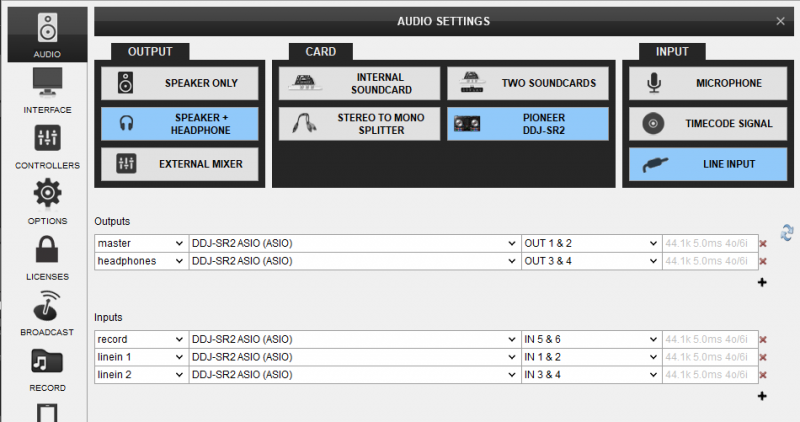

If Line In and/or Timecode Inputs are applied to the Audio Setup of VirtualDJ, enable LINE IN or TIMECODE on Decks 1/2 from the offered GUI buttons in order the signal of the CH1/CH2 Inputs of the DDJ-SR2 to be used as Inputs from VirtualDJ Decks 1/2.
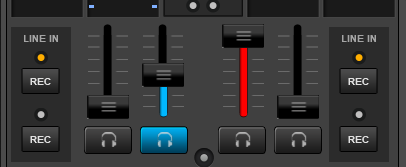
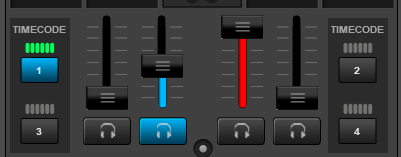
RECORDING
The USB Audio interface of the DDJ-SR2 offers a special Record Input on Channels 5&6, which is included in the default Audio configuration (offered from the special DDJ-SR2 button in the AUDIO tab of VirtualDJ Settings). This input allows to record both VirtualDJ mixing and the audio signal from the Inputs of the DDJ-SR2 (CH1, CH2 and MIC).
MICROPHONE
The audio signal from the Microphone Input of the DDJ-SR2 (connection at the rear panel) is directly routed to the Master Output (hardware operation), regardless the selected Software/Hardware Inputs Route mode. The level of this input is controlled by the MIC LEVEL knob at the front panel of the unit.
This input is not part of the USB Audio Interface, thus no Mic Input should be added to the Audio configuration of VirtualDJ, nor the MIC LEVEL knob at the front should be assigned to control the Microphone Volume of VirtualDJ internal MIC (even though the knob sends MIDI and can be assigned to a VDJ Script action)
The audio signal of the Microphone Input is recorded along with the VirtualDJ mixing and CH1/CH2 Input Sources.
OTHER SETTINGS
The DDJ-SR2 offers firmware Settings via UTILITIES mode, such as Jog illumination and Fader Start modes. Read DDJ-SR2 Manual for further details.
JOG ILLUMINATION
The LED ring of the DDJ-SR2 can operate in 3 different modes, offering useful information while mixing.
How to select the Jog Illumination Mode:
- While the DDJ-SR2 is powered off, hold both left SYNC and left PLAY buttons and then power on the unit.
- Release SYNC and PLAY buttons
- Use the FX1 ON, FX2 ON or FX3 ON buttons on the right FX unit to select one of the 3 available modes for the Jog Illumination
[list] - When FX1 ON is turned on (default mode):
- The Jog Ring will be lit in red when DECK 1 or DECK 2 is selected from the mixer SOURCE select switches.
- The Jog Ring will be lit in amber when DECK 3 or DECK 4 is selected from the mixer SOURCE select switches
- The Jog Ring will be off when PHONO/LINE is selected from the mixer SOURCE select switches. - When FX2 ON is turned on:
- The Jog Ring will be lit in blue when the VINYL mode is enabled on the selected Deck.
- The Jog Ring will be off when the VINYL mode is disabled on the selected Deck. - When FX3 ON is turned on:
- The Jog Ring will be lit with the assigned color of the loaded track.
- The Jog Ring will be off if no color is assigned (default) to the loaded track.
- In this mode, the color of the Jog ring can be customized via VDJ script actions assigned to the LED_JOG key
FADER START/STOP/SYNC
The DDJ-SR2 offers the ability to enable/disable the Fader Start/Stop/Sync functionality when SHIFT is pressed and the VOLUME faders are moved from minimum to other position or vice versa.
How to select the SHIFT+Volume Fader Mode:
[list]
- Fader Start/Stop functionality is enabled, along with the Sync mode. When SHIFT+Volume fader is moved from the minimum position to any other, the Deck will start playing and will be also synced to the opposite/master deck. When SHIFT+Volume is moved to the minimum position, the Deck will stop at the CUE position.
- Fader Start/Stop functionality is enabled, but without the Sync mode. When SHIFT+Volume fader is moved from the minimum position to any other, the Deck will start playing but will not be synced to the opposite/master deck. When SHIFT+Volume is moved to the minimum position, the Deck will stop at the CUE position.
- Fader Start/Stop functionality is disabled. When SHIFT+Volume fader is moved, no additional functionality will apply.
[*] Power off the DDJ-SR2 to save your selection.[/list]
